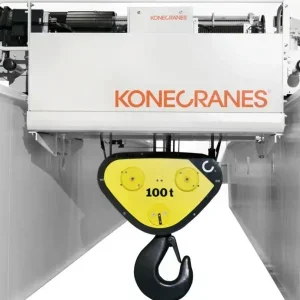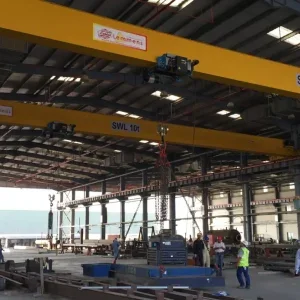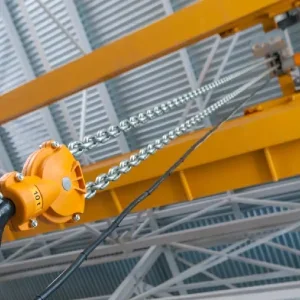Sometimes, spent nuclear fuel is transferred to storage casks within a canister, which is itself inside a temporary transfer cask.
Once the transfer cask is positioned above the storage cask, the two are tied together to minimise movement. Then the crane assembly is disconnected from the transfer cask and attached to the canister. Then a hatch opens in the bottom of the transfer cask and the canister is lowered into the cask.
While the foregoing process has been performed innumerable times safely and in compliance with applicable regulations, it requires a substantial amount of time and skill to perform. In addition, to the extent that human labour is needed to immobilize the transfer cask and to undo the immobilization at the end of the procedure there is a risk that personnel may be subjected to potentially harmful radiation.
The solution
Referring to Fig. 10, an apparatus 310 for moving a canister of spent nuclear fuel includes a first single failure proof lifting mechanism 312 for engaging and lifting a transfer cask 18 in which a canister 12 of spent nuclear fuel is temporarily positioned. Apparatus 310 further includes a second, independent single failure proof lifting mechanism 314 for engaging a lid assembly 316 of the canister 12 of spent nuclear fuel. As may be seen in Fig. 10, apparatus 310 further includes a trolley assembly 324 that is mounted so as to be able to travel on a pair of travel rails 320,322 that are preferably, although not necessarily, structurally mounted to a building 326.
Referring briefly to Fig. 11, it will be seen that the first lifting mechanism 312 includes a drive motor 328 that is adapted to drive a first drive mechanism 330, which in turn causes movement of a first drum 332, as well as to drive a second drive mechanism 334, which is arranged to cause movement of a second drum 336. A plurality of parts of rope are paid out from the respective drums 332, 336 to raise or lower as may be desired a lower block assembly 338, best visible in Fig. 10, which includes a plurality of sheaves 340 for receiving and equalizing the parts of rope. The lower block assembly 338 further includes a first lifting member 342 and a second lifting member 344 that are constructed and arranged to be engageable with lifting lugs 34, 36 of the transfer cask 18. In this embodiment, lifting members 342, 344 are constructed so as to be shaped as closed hooks or eyelets, although they could alternatively be shaped as open hooks as was described in reference to the first embodiment of the invention.
Second lifting mechanism 314 is preferably embodied as a hoist 346 that, as may be seen in Fig. 12, includes a drive motor 348. Drive motor 348 is coupled to a first drive train 350 the drives a first hoist drum 352 as well as to a second drive train 354 that in turn is coupled to a second hoist drum 356. First and second pairs of wire ropes 358, 360 are respectively paid out of the hoist drums 352, 356 to control upward and downward movement of a canister grab mechanism 366. As is best shown in Fig. 14, canister grab mechanism 366 includes a first pair of coupling mechanisms 362 that are coupled with the first pair 358 of wire ropes and a second pair of coupling mechanisms 364 that are likewise coupled to the second pair 360 of wire ropes.
As may be seen in Figs. 14-15, canister 12 includes a lifting ring 368 that has an oblong opening 370 defined therein. Canister grab system 366 has an outer housing 372 to which is mounted a drive motor 374 that is adapted to drive a male conical drive member 378 via a reduction gear train 376. Male conical drive member 378 is positioned so as to be able to engage a female conical drive member 380 when the canister grab system 366 is not bearing the weight of the canister 12, in a manner that is identical to that described above with reference to the first embodiment of the invention. In this condition, the weight of members 374, 376, 378 urges the female conical drive member 380 into engagement with the male conical drive member 378. A pair of springs 388 provides braking for the members 374, 376, 378 when the lower portion of the grab mechanism 366 is bearing weight, thus preventing engagement of the drive members 378, 380. Female conical drive member 380 is coupled to rotate together with an engagement member 382 that includes a lower portion 384 that is constructed and arranged to engage the lid assembly 316 of the canister 12. Specifically, and as is best shown in Fig. 15, the lower portion 384 of the engagement member 382 is shaped so as to be able to fit through the oblong opening 370 of the lifting ring 368, and so that it will be locked within the lifting ring 368 after it has been inserted through the opening 370 and rotated so as to no longer be in registration with the opening 370, as will be described in greater detail below. The lower portion 384 of the engagement member 382 preferably has a lower beveled edge 386 to facilitate centering and location of the engagement member 382 with respect to the upper portion of a canister 12 during coupling. A sensor 390 may be provided to monitor the engagement status of the lower portion 384 of the engagement member 382 with the lifting ring 368. Sensor 390 may be embodied as a first sensor for sensing when the lower portion 384 is seated in the lifting ring 378 and a second sensor for sensing the rotational position of the lower portion 384 with lifting ring 378.
Operation
In operation, the canister 12 will first be positioned and secured within the transfer cask 18 and the transfer cask 18 will then be engaged by the first lifting mechanism 312, specifically by engagement of the lifting members 342, 344 with the corresponding lifting lugs 34, 36 on the sides of the outer wall 38 of the transfer cask 18. At this point, the first lifting mechanism 312 will be used to move the transfer cask 18 and the enclosed canister 12 to a position (as is shown in Fig. 1) immediately above the storage cask 14. At any point in the process up to and including this point, the canister grab system 366 may be lowered automatically or by an operator by instructing the hoist 346 to be lowered into the proximity of the lid assembly 316 of the canister 12. The lower portion 384 of the engagement member 382 will be lowered through the opening 370 in the lid assembly 316, and the motor 374 will then be actuated, causing a engagement member 382 to rotate, thereby locking the engagement member into the lid assembly 316 as is depicted in Fig. 15. This is verified by the sensor 390, which will so advise a remote human operator or an automated control system. At this point, while the first lifting system 312 remains engaged with the transfer cask 18, the gate mechanism 42 at the lower end of the transfer cask 18 may be opened, preferably by remote control. The hoist 346 may be instructed to lower the canister 12 into the space 44 that is defined within the storage cask 14. Because the canister grab system 366 is suspended directly from the trolley assembly 324, rather than the lower block of the first lifting assembly. As was the case in the previously described embodiment, the overall height of the system is reduced, making it compatible with more facilities, particularly indoor facilities. In addition, the fact that the sensitive electrical parts of the hoist 346 are not suspended from the lower block of the first lifting mechanism makes the canister grab mechanism 366 less likely to be submerged in water during use, which is an important advantage. As was the case in the previously described embodiment, the fact that simultaneous engagement is provided with the transfer cask 18 and the canister 12 provides relative stability during the step of lowering the canister 12. Accordingly, is not necessary for the transfer cask 18 to be tied down using supplemental restraints which, as described above, is a time-consuming process in may also result in the exposure of humans to potentially harmful radiation. As the canister 12 is lowered, the conical drive members 378, 380 will be pulled into the disengaged position that is shown in Fig. 14, so that the grab system 366 may not be accidentally disengaged. When the canister 12 is in the final storage position, the control system or remote human operator will instruct the electric motor 374 to disengage the engagement member 382 from the lid assembly 316 of the canister 12. The hoist 346 will then be instructed to retract the grab system 366, and the first lifting mechanism may then be instructed to transport the transfer cask to another location where it may be stored or used in a second transfer procedure.






